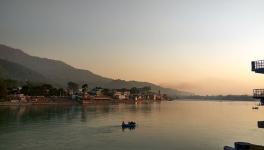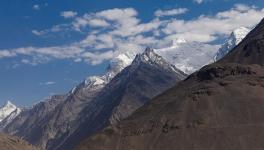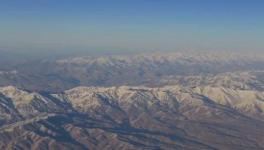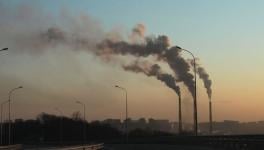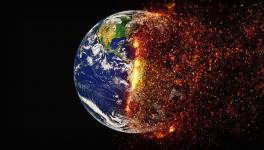In My Own Voice: The Cry of the Peacock

Representational image. | Image Courtesy: Jagran
I live in hot, polluted Delhi. Last month, as temperatures reached 46 degree Celsius, fevered sparrows fell on the asphalt. Across the Northern plains, many people died in an unprecedented heat wave. The humble five paise piao (water vendor) has been replaced by bottled water in plastic.
There is a peacock that comes to my terrace and cries. His cry is for water to quench thirst. And, perhaps, also for the unbearable position we have put all life into, for we are now facing a sixth wave of mass extinction. This is the worst spate of species extinctions since the loss of dinosaurs, 65 million years ago. While earlier species were lost due to an asteroid strike, volcanic eruption or a natural climate shift, we are doing this by presiding over the age of the Anthropocene; our own human intervention has put over a million species at risk, documents a recent United Nations (UN) report.
Last month, I took a much-needed vacation to the Dhauladar range in the Himalayas. As I reached my room, I looked out with deep gratitude at the forest below. The air was pure and I was filled with the sense of peace and well-being that comes from being in the mountains. Then I noticed a line of light in the forest. I asked my little daughter to look at it and she reassured me, ‘Mama, it’s just a light’. Tired, we went to sleep. When I awoke at around 1 am, I went out into the balcony to see that an enormous forest fire was raging!
I called the hotel receptionist and asked him to call the Fire Department. Another call to him, he had not done so – I asked him to do so immediately and the call would be in my name. I assured him I would take complete responsibility. Another call later, I asked him if he had reported the fire. He had indeed done so, but the department officials had informed him that their ‘engines were too huge to get to the forest’. Also, they had asked him if he would take them to the spot. I told him to tell them to come and see for themselves, there was a forest fire raging in front of my window. No one came! Gentle reader, I fumed and raged as the forest burned below, but fortunately there was a rumble of thunder and a few drops of rain, followed by a shower. It was nature that extinguished the fire, not the Fire Department. To be fair to the fire authorities, perhaps a forest fire is too big an issue for them, but as the natural resources of the world burn, can we have a policy please? Can we have helicopters for dousing fires? Can we educate people not to leave half-lit bidis and cigarettes or to set a fire to clear space to plant crops?
Something has to be done and now.
The UN report says there are a million species at risk of extinction, but there are probably many more, as so many species are not known or documented. There is an insect apocalypse—thanks to the indiscriminate use of chemicals—one third of marine mammals and 40% of the planet’s amphibian species are facing extinction!
Some species that are dying are just microbes and since they are not visible to the naked eye, it is not easy to count them or mourn their loss like tigers, rhinos or dolphins. In a world only reduced to numbers and net economic worth, how does one acknowledge that a soil microbe could lead to the loss of a tree that gave the fruit for birds and monkeys to eat, that in turn fed the predators that now haunt human habitations, searching for food? Then, the loss of insects that pollinate the tree, the snail that helped break down the decaying leaves and snakes and lizards that ate the snail that used the humble soil microbe. This sounds like an endless probe over the microbe, but it is elementary my dear Watson!
What we are truly facing is a crisis of morality and a crisis of ethics, for we have embarked on an ease to do business and an increase the Gross Domestic Product model. However, I ask you, if you give a license to mine the mountain of Niyamgiri in Orissa – displacing the villagers and destroying the natural resource base developed over centuries – is that growth or destruction?
Recently, the billionaire, Mukesh Ambani, expressed his ambition to construct a ropeway and resort in Dharamshala, but if his lofty dreams are concretised, the Himalayan range will be reduced to just that – concrete. As huge SUVs and cars swept over the Himalayan range, I experienced how impossible it was to walk in the narrow streets that our mountains have. The traffic jams in Mussoorie and Mcleodganj were horrific, but instead of constructing ropeways and resorts, what we need is a special plan for the Himalayas. Park the vehicle in the plains below – with a parking fee – get into battery operated, small vehicles driven by the mountain folk. When we go to the mountains, let us support the livelihoods and crafts of the Himalayas and leave our commercial city lifestyle; take only photographs and leave just our footprints behind.
We need to walk like pilgrims on the Himalayas. People earlier used to walk to the Chaar Dhams as an expression of faith and endurance but the Ambani dream will destroy an entire ecosystem. We need to invest in rainwater harvesting and solar energy; the renewable forms of energy are the only way forward. Instead the Indian government has sanctioned 10 nuclear plants for electricity.
After the Chernobyl and Fukushima nuclear disasters, Russia, Germany and Japan are phasing out their nuclear plants. Nuclear technology is too dangerous, the Fukoshima leak occurred after an earthquake; the Chernobyl and the Three Mile island leak can happen in India too; we need to talk about sustainable development, something that works for the living earth that includes trees, plants and human beings too.
As we deal with accelerated glacial retreat, diminishing forest cover, drying of rivers as water is diverted for big dams and the unprecedented infrastructural development, we are entering a new phase of extinction where our own future is threatened.
In 1909 a frail man wrote, ‘I bear no enmity to the British, but I do towards their civilisation’. The military-industrial-nuclear model is fast losing its sheen in the West as the earth is slated towards global warming and climate change, but we in India with our ‘ease to do business’ approach, seem we have embraced that outdated model the whole hog. The big dams can no longer be ‘India’s new temples’.
The message of Gandhi’s Hind Swaraj is a call to be aware of the essence of man to co-exist with nature and each other. However, we seem to cite Gandhi and go ahead with ‘himsa’ (violence).
Meanwhile, the peacock on my terrace cries and cries relentlessly; will we listen to the cry of the peacock?
The author is an award-winning author and film director. Views are personal.
Also read: In My Own Voice: Why I Write
Get the latest reports & analysis with people's perspective on Protests, movements & deep analytical videos, discussions of the current affairs in your Telegram app. Subscribe to NewsClick's Telegram channel & get Real-Time updates on stories, as they get published on our website.











